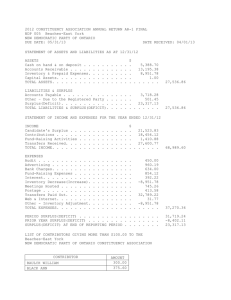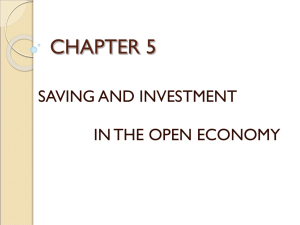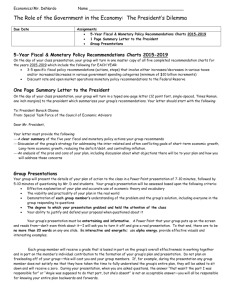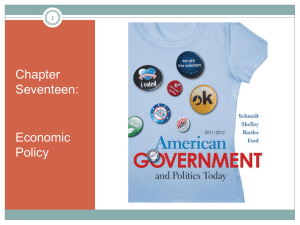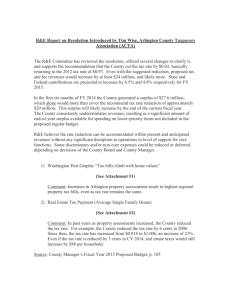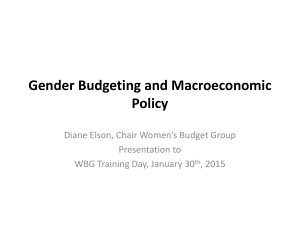CHAPTER 17 MACROECONOMIC POLICY IN AN OPEN ECONOMY
advertisement
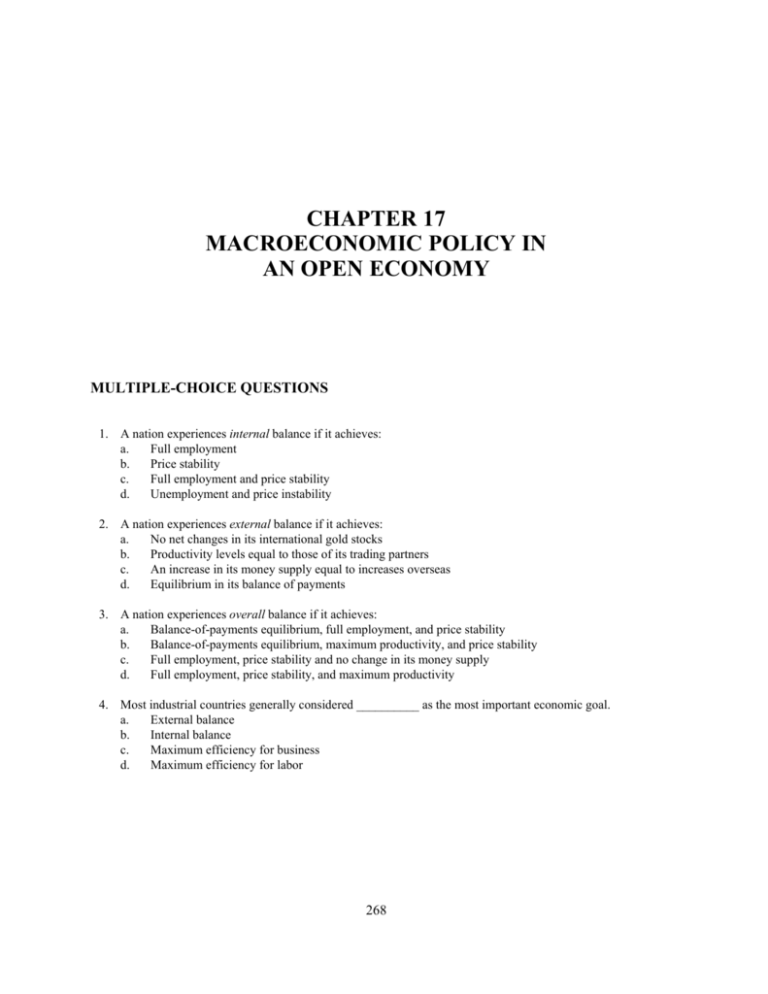
CHAPTER 17 MACROECONOMIC POLICY IN AN OPEN ECONOMY MULTIPLE-CHOICE QUESTIONS 1. A nation experiences internal balance if it achieves: a. Full employment b. Price stability c. Full employment and price stability d. Unemployment and price instability 2. A nation experiences external balance if it achieves: a. No net changes in its international gold stocks b. Productivity levels equal to those of its trading partners c. An increase in its money supply equal to increases overseas d. Equilibrium in its balance of payments 3. A nation experiences overall balance if it achieves: a. Balance-of-payments equilibrium, full employment, and price stability b. Balance-of-payments equilibrium, maximum productivity, and price stability c. Full employment, price stability and no change in its money supply d. Full employment, price stability, and maximum productivity 4. Most industrial countries generally considered __________ as the most important economic goal. a. External balance b. Internal balance c. Maximum efficiency for business d. Maximum efficiency for labor 268 Chapter 17: Macroeconomic Policy in an Open Economy 269 5. Which policies are expenditure-changing policies? a. Currency devaluation and revaluation b. Import quotas and tariffs c. Monetary and fiscal policy d. Wage and price controls 6. Which policy is an expenditure-switching policy? a. Increase in the money supply b. Decrease in government expenditures c. Increase in business and household taxes d. Decrease in import tariffs 7. An expenditure-increasing policy would consist of an increase in: a. Import tariffs b. Import quotas c. Governmental taxes d. The money supply 8. An expenditure-reducing policy would consist of a decrease in: a. The par value of a currency b. Government expenditures c. Import duties d. Business or household taxes 9. Given fixed exchange rates, assume Mexico initiates expansionary monetary and fiscal policies to combat recession. These policies will also: a. Increase both imports and exports b. Increase exports and reduce imports c. Reduce a balance-of-payments surplus d. Reduce a balance-of-payments deficit 10. Given fixed exchange rates, assume Mexico initiates contractionary monetary and fiscal policies to combat inflation. These policies will also: a. Reduce a balance-of-payments surplus b. Reduce a balance-of-payments deficit c. Increases both imports and exports d. Decrease both imports and exports 11. The appropriate expenditure-switching policy to correct a balance-of-payments surplus is: a. Currency revaluation b. Currency devaluation c. Expansionary monetary policy d. Contractionary fiscal policy 270 Test Bank for International Economics, 9e 12. The appropriate expenditure-switching policy to correct a balance-of-payments deficit is: a. Contractionary monetary policy b. Expansionary fiscal policy c. Currency devaluation d. Currency revaluation 13. Suppose the United States faces domestic recession and a balance-of-payments deficit. Should the United States devalue the dollar, one would expect the: a. Recession to become less severe—deficit to become less severe b. Recession to become more severe—deficit to become less severe c. Recession to become less severe—deficit to become more severe d. Recession to become more severe—deficit to become more severe 14. Suppose the United States faces domestic inflation and a balance-of-payments surplus. Should the United States revalue the dollar, one would expect the: a. Inflation to become more severe—surplus to become less severe b. Inflation to become less severe—surplus to become less severe c. Inflation to become less severe—surplus to become more severe d. Inflation to become more severe—surplus to become more severe 15. Suppose Brazil faces domestic recession and a balance-of-payments surplus. Should Brazil revalue its currency, one would expect the: a. Recession to become less severe—surplus to become less severe b. Recession to become more severe—surplus to become more severe c. Recession to become more severe—surplus to become less severe d. Recession to become less severe—surplus to become more severe 16. Suppose that Brazil faces domestic inflation and a balance-of-payments deficit. Should Brazil devalue its currency, one would expect the: a. Inflation to become more severe—deficit to become less severe b. Inflation to become more severe—deficit to become more severe c. Inflation to become less severe—deficit to become less severe d. Inflation to become less severe—deficit to become more severe 17. Suppose the United States faces internal balance and a balance-of-payments surplus. The appropriate policy for achieving overall balance would be: a. Currency devaluation and restrictive fiscal policy b. Currency devaluation and expansionary fiscal policy c. Currency revaluation and restrictive fiscal policy d. Currency revaluation and expansionary fiscal policy 18. Suppose the United States faces external balance and inflation. The appropriate policy for achieving overall balance would be: a. Restrictive monetary policy and currency revaluation b. Restrictive monetary policy and currency devaluation c. Expansionary monetary policy and currency revaluation d. Expansionary monetary policy and currency devaluation Chapter 17: Macroeconomic Policy in an Open Economy 271 19. A problem that economic policy makers confront when attempting to promote both internal and external balance for the nation is that monetary or fiscal policies aimed at the domestic sector also have impacts on: a. Trade flows only b. Capital flows only c. both trade flows and capital flows d. Neither trade flows nor capital flows 20. Concerning the relative impacts of fiscal policy and monetary policy on the balance of payments, in order to achieve a $1 billion reduction in a payments surplus: a. Fiscal policy must be more expansionary than monetary policy b. Monetary policy must be more expansionary than fiscal policy c. Fiscal policy must be more contractionary than monetary policy d. Monetary policy must be more contractionary than fiscal policy 21. Under a system of fixed exchange rates, which of the following policies promotes internal balance for a nation? a. Fiscal policy b. Monetary policy c. Both fiscal policy and monetary policy d. Neither fiscal policy nor monetary policy 22. Under a system of floating exchange rates, which of the following policies promotes internal balance for a nation? a. Fiscal policy b. Monetary policy c. Both fiscal policy and monetary policy d. Neither fiscal policy nor monetary policy 23. Concerning the pursuit of internal balance under a fixed exchange rate system: a. Fiscal policy is successful in promoting internal balance, while monetary policy is unsuccessful b. Monetary policy is successful in promoting internal balance, while fiscal policy is unsuccessful c. Both fiscal policy and monetary policy are successful in promoting internal balance d. Neither fiscal policy nor monetary policy are successful in promoting internal balance 24. Under a system of managed-floating exchange rates with heavy exchange rate intervention: a. Fiscal policy is successful in promoting internal balance, while monetary policy is unsuccessful b. Monetary policy is successful in promoting internal balance, while fiscal policy is unsuccessful c. Both fiscal policy and monetary policy are successful in promoting internal balance d. Neither fiscal policy nor monetary policy are successful in promoting internal balance 25. Under a system of managed-floating exchange rates with modest exchange rate intervention: a. Fiscal policy is successful in promoting internal balance, while monetary policy is unsuccessful b. Monetary policy is successful in promoting internal balance, while fiscal policy is unsuccessful c. Both fiscal policy and monetary policy are successful in promoting internal balance d. Neither fiscal policy nor monetary policy are successful in promoting internal balance 272 Test Bank for International Economics, 9e 26. All of the following are examples of international economic policy coordination except the: a. Plaza Accord of 1985 b. Smithsonian Agreement of 1971 c. Tokyo Round of MTN of 1981 d. Bonn Summit of 1978 27. All of the following are obstacles to international economic policy coordination except: a. Different national objectives and institutions b. Different national political climates c. Different phases in the business cycle d. Different national currencies 28. At the __________, the United States agreed to raise domestic oil prices to world levels, while Germany and Japan agreed to initiate expansionary fiscal policies. a. Bonn Summit of 1978 b. Smithsonian Agreement of 1971 c. Plaza Agreement of 1985 d. Louvre Accord of 1987 29. At the __________, the Group-of-Five nations agreed to intervene in the currency markets to promote a depreciation in the U.S. dollar’s exchange value. a. Plaza Agreement of 1985 b. Louvre Accord of 1987 c. Bonn Summit of 1978 d. Tokyo Summit of 1962 30. The Plaza Agreement of 1985 and Louvre Accord of 1987 are examples of: a. Tariff trade barrier formation b. Nontariff trade barrier formation c. International economic policy coordination d. Beggar-thy-neighbor policies At the Plaza Accord of 1985, the Group-of-Five nations agreed to drive the value of the dollar downward (i.e., depreciation) so as to help reduce the U.S. trade deficit. Answer the next two questions on the basis of this information. 31. To help drive the dollar’s exchange value downward, the Federal Reserve would: a. Reduce taxes b. Increase taxes c. Decrease the money supply d. Increase the money supply Chapter 17: Macroeconomic Policy in an Open Economy 273 32. The Federal Reserve might refuse to support the accord on the grounds that when helping to drive the dollar’s exchange value downward, it promotes an increase in the U.S.: a. Rate of inflation b. Budget deficit c. Unemployment level d. Economic growth rate 33. Under a fixed exchange-rate system, an expansion in the domestic money supply leads to: a. Trade-account deficit and a capital-account surplus b. Trade-account deficit and a capital-account deficit c. Trade-account surplus and a capital-account surplus d. Trade-account surplus and a capital-account deficit 34. Under a fixed exchange-rate system, a contraction in the domestic money supply leads to a: a. Trade-account deficit and a capital-account surplus b. Trade-account deficit and a capital-account deficit c. Trade-account surplus and a capital-account surplus d. Trade-account surplus and a capital-account deficit 35. Under a fixed exchange-rate system, an expansionary fiscal policy leads to a: a. Trade-account deficit and a capital-account surplus b. Trade-account deficit and a capital-account deficit c. Trade-account surplus and a capital-account surplus d. Trade-account surplus and a capital-account deficit 36. Under a fixed exchange-rate system, a contractionary fiscal policy leads to a: a. Trade-account deficit and a capital-account surplus b. Trade-account deficit and a capital-account deficit c. Trade-account surplus and a capital-account surplus d. Trade-account surplus and a capital-account deficit 37. Under a fixed exchange-rate system, an expansionary fiscal policy leads to an improvement in a nation’s balance-of-payments position if the resulting: a. Trade-account deficit more than offsets the capital-account surplus b. Trade-account deficit more than offsets the capital-account deficit c. Capital-account surplus more than offsets the trade-account deficit d. Capital-account surplus more than offsets the trade-account surplus 38. Under a fixed exchange-rate system, an expansionary fiscal policy leads to a worsening in a nation’s balance-of-payments position if the resulting: a. Trade-account deficit more than offsets the capital-account surplus b. Trade-account deficit more than offsets the capital-account deficit c. Trade-account surplus more than offsets the capital-account surplus d. Trade-account surplus more than offsets the capital-account deficit 274 Test Bank for International Economics, 9e 39. Under a fixed exchange-rate system, a contractionary fiscal policy leads to an improvement in a nation’s balance-of-payments position if the resulting: a. Trade-account deficit more than offsets the capital-account surplus b. Trade-account deficit more than offsets the capital-account deficit c. Trade-account surplus more than offsets the capital-account surplus d. Trade-account surplus more than offsets the capital-account deficit 40. Under a fixed exchange rate system, a contractionary fiscal policy leads to a worsening in a nation’s balance-of-payments position if the resulting: a. Trade-account deficit more than offsets the capital-account surplus b. Trade-account deficit more than offsets the capital-account deficit c. Capital-account deficit more than offsets the trade-account surplus d. Capital-account deficit more than offsets the trade-account deficit TRUE-FALSE QUESTIONS T F 1. A nation realizes its internal balance its economy achieves full employment and price stability. T F 2. Nations have typically placed greater importance to the goal of internal balance than to the goal of external balance. T F 3. A nation realizes external balance when its balance of payments is in equilibrium. T F 4. A nation realizes overall balance when it achieves full employment and balance of payments equilibrium. T F 5. Expenditure-changing policies modify the direction of aggregate demand, shifting it between domestic output and imports. T F 6. Expenditure-changing policies include fiscal policy and monetary policy. T F 7. Economic policymakers have typically adopted expenditure-increasing policies to combat inflation and expenditure-reducing policies to combat recession. T F 8. Expenditure-switching policies modify the direction of demand, shifting it between domestic output and imports. T F 9. currency devaluation and revaluation are considered to be expenditure-changing policies since they alter a country’s aggregate demand for goods and services. T F 10. Expenditure-switching policies include currency revaluation, currency devaluation, and direct controls such as tariffs, quotas, and subsidies. T F 11. Refer to Figure 17.1. The economy achieves overall balance at point 0. Chapter 17: Macroeconomic Policy in an Open Economy 275 Figure 17.1 Position of the U.S. Economy T F 12. Refer to Figure 17.1. At point A, the economy realizes internal balance but not external balance. T F 13. Refer to Figure 17.1. At point C, the economy realizes internal balance with a balance-ofpayments surplus. T F 14. Refer to Figure 17.1. At point G, the economy realizes a balance-of-payments deficit with domestic recession. T F 15. Refer to Figure 17.1. If the economy was located at point B, overall balance could be achieved via a devaluation of the dollar. T F 16. Refer to Figure 17.1. If the economy was located at point F, overall balance could be achieved by a revaluation of the dollar. T F 17. Refer to Figure 17.1. If the economy was located at point D, a dollar revaluation would move the economy towards external balance but not towards internal balance. T F 18. Refer to Figure 17.1. If the economy is located at point F, a devaluation of the dollar would move it towards overall balance. T F 19. Refer to Figure 17.1. If the economy is located at point G, a dollar devaluation would promote external balance but not internal balance. T F 20. Refer to Figure 17.1. If the economy is located at point G, a dollar revaluation would promote overall balance. 276 Test Bank for International Economics, 9e T F 21. Currency devaluation best promotes overall balance when an economy is located in the disequilibrium zone of balance-of-payments surplus with recession. T F 22. Currency revaluation best promotes overall balance when an economy is located in the disequilibrium zone of balance-of-payments surplus with inflation. T F 23. Exchange rate management policies require international policy coordination because a depreciation of one nation’s currency implies an appreciation of its trading partner’s currency. T F 24. Under floating exchange rates, monetary policy is effective in promoting internal balance while fiscal policy is ineffective. T F 25. Under floating exchange rates, fiscal policy is effective in promoting internal balance while monetary policy is ineffective. T F 26. With fixed exchange rates, monetary policy is effective in promoting internal balance while fiscal policy is ineffective. T F 27. With fixed exchange rates, fiscal policy is effective in promoting internal balance while monetary policy is ineffective. T F 28. Currency devaluation and revaluation primarily affect the economy’s balance of payments and have secondary effects on domestic employment and price levels. T F 29. Fiscal and monetary policies are generally used to combat domestic recession and inflation and have secondary effects on the balance of payments. T F 30. With fixed exchange rates, an expansionary monetary policy leads to an improvement in a country’s trade account and capital account. T F 31. With fixed exchange rates, an expansionary monetary policy results in a worsening of a country’s trade account and capital account. T F 32. With fixed exchange rates, an increase in government spending results in an improvement in a country’s trade account and capital account. T F 33. With fixed exchange rates, an increase in government spending results in an improvement in a country’s trade account but a worsening in its capital account. T F 34. With fixed exchange rates, an increase in government spending leads to an improvement in a country’s overall balance if the resulting capital-account surplus exceeds the trade deficit. T F 35. With fixed exchange rates, a restrictive monetary policy results in a worsening of a country’s trade account and capital account. T F 36. With fixed exchange rates, a restrictive fiscal policy results in a trade deficit and net capital outflows for a country. 277 Chapter 17: Macroeconomic Policy in an Open Economy T F 37. With fixed exchange rates, a restrictive fiscal policy will improve a country’s balance of payments position if the resulting trade-account surplus exceeds the capital-account deficit. T F 38. The Smithsonian Agreement of 1971, Bonn Summit of 1978, and Plaza Accord of 1985 are examples of international policy coordination. T F 39. International policy coordination is plagued by differing national economic objectives, institutions, political climates, and phases in the business cycle. T F 40. According to the Bonn Summit Agreement of 1978, the United States devalued its dollar by 10 percent while Germany and Japan revenued their currencies by 8 percent each. T F 41. according to the Bonn Summit Agreement of 1978, Germany and Japan agreed to initiate contractionary fiscal policies in exchange for a commitment by the United States to lower domestic oil prices to world levels. T F 42. The goals of the Plaza Agreement of 1985 were to combat protectionism in the U.S. Congress, promote world economic expansion by stimulating demand in Germany and Japan, and to ease the burden of the U.S. debt service. T F 43. At the Plaza Agreement of 1985, Germany and Japan agreed to initiate contractionary fiscal policies in exchange for a U.S. commitment to bring down its budget surplus. T F 44. At the Louvre Accord of 1987, the major industrial countries adopted a policy of leaning against the wind by purchasing dollars to drive its exchange value upward. T F 45. The Group of five (G-5) nations include Japan, Germany, France, the United Kingdom, and the United States. T F 46. At the Plaza Agreement of 1985, Germany and Japan pledged to purchase the U.S. dollar with their currencies in order to support the dollar’s exchange value. ANSWERS Answers to Multiple-Choice Questions 1. 2. 3. 4. 5. 6. 7. 8. c d a b c d d b 9. 10. 11. 12. 13. 14. 15. 16. c b a c a b c a 17. 18. 19. 20. 21. 22. 23. 24. d a c a a b a b 25. 26. 27. 28. 29. 30. 31. 32. a c d a a c d a 33. 34. 35. 36. 37. 38. 39. 40. b c a d c a d c 278 Test Bank for International Economics, 9e Answers to True-False Questions 1. 2. 3. 4. 5. 6. 7. 8. 9. 10. T T T T T T F T F T 11. 12. 13. 14. 15. 16. 17. 18. 19. 20. T F T F F F T T T F 21. 22. 23. 24. 25. 26. 27. 28. 29. 30. F T T F F F T T T F 31. 32. 33. 34. 35. 36. 37. 38. 39. 40. F F F T F F T T T F 41. 42. 43. 44. 45. 46. F T F T T F


